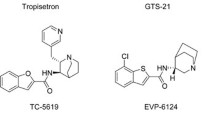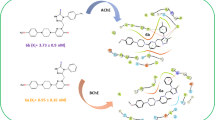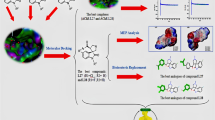Abstract
Acetylcholinesterase (AChE) is a critical enzyme that regulates neurotransmission by degrading the neurotransmitter acetylcholine in synapses of the nervous system. It is an important target for both therapeutic drugs that treat Alzheimer’s disease and organophosphate (OP) chemical warfare agents that cripple the nervous system and cause death through paralysis. We are exploring a strategy to design compounds that bind tightly at or near a peripheral or P-site near the mouth of the AChE active site gorge and exclude OPs from the active site while interfering minimally with the passage of acetylcholine. However, to target the AChE P-site, much more information must be gathered about the structure-activity relationships of ligands that bind specifically to the P-site. Here, we review our recent reports on two uncharged, natural product inhibitors of AChE, dihydrotanshinone I and territrem B, that have relatively high affinities for the enzyme. We describe an inhibitor competition assay and comment on the structures of these inhibitors in complex with recombinant human acetylcholinesterase as determined by X-ray crystallography. Our results reveal that dihydrotanshinone I binding is specific to only the P-site, while territrem B binding spans the P-site and extends into the acylation or A-site at the base of the gorge.


Similar content being viewed by others
Abbreviations
- AChE:
-
Acetylcholinesterase
- OPs:
-
Organophosphates
- RMSD:
-
Root-mean-square deviation
References
Auletta JT, Johnson JL, Rosenberry TL (2010) Molecular basis of inhibition of substrate hydrolysis by a ligand bound to the peripheral site of acetylcholinesterase. Chem Biol Interact 187:135–141
Beri V, Wildman SA, Shiomi K, Al-Rashid ZF, Cheung J, Rosenberry TL (2013) The natural product dihydrotanshinone I provides a prototype for uncharged inhibitors that bind specifically to the acetylcholinesterase peripheral site with nanomolar affinity. Biochemistry 52:7486–7499
Bourne Y, Taylor P, Radic Z, Marchot P (2003) Structural insights into ligand interactions at the acetylcholinesterase peripheral anionic site. EMBO J 22:1–12
Camps P, Cusack B, Mallender WD, El Achab R, Morral J, Muñoz-Torrero D et al (2000) Huprine X is a novel high affinity inhibitor of acetylcholinesterase that is of interest for the treatment of Alzheimer’s disease. Mol Pharmacol 57:409–417
Changeux J-P (1966) Responses of acetylcholinesterase from Torpedo marmorata to salts and curarizing drugs. Mol Pharmacol 2:369–392
Cheung J, Rudolph MJ, Burshteyn F, Cassidy MS, Gary EN, Love J et al (2012) Structures of human acetylcholinesterase in complex with pharmacologically important ligands. J Med Chem 55:10282–10286
Cheung J, Gary EN, Shiomi K, Rosenberry TL (2013) Structures of human acetylcholinesterase in complex with the natural products dihydrotanshinone I and territrem B. ACS Med Chem Lett 4:1091–1096
De Ferrari GV, Mallender WD, Inestrosa NC, Rosenberry TL (2001) Thioflavin T is a fluorescent probe of the acetylcholinesterase peripheral site that reveals conformational interactions between the peripheral and acylation sites. J Biol Chem 276:23282–23287
Giacobini E (2000) Cholinesterase inhibitors: from the Calabar bean to Alzheimer therapy. In: Giacobini E (ed) Cholinesterases and cholinesterase inhibitors. From molecular biology to therapy. Martin Dunitz, London, pp 181–222
Harel M, Quinn DM, Nair HK, Silman I, Sussman JL (1996) The X-ray structure of a transition state analog complex reveals the molecular origins of the catalytic power and substrate specificity of acetylcholinesterase. J Am Chem Soc 118:2340–2346
Harel M, Sonoda LK, Silman I, Sussman JL, Rosenberry TL (2008) The crystal structure of thioflavin T bound to the peripheral site of Torpedo californica acetylcholinesterase reveals how thioflavin T acts as a sensitive fluorescent reporter of ligand binding to the acylation site. J Am Chem Soc 130:7856–7861
Hoffman BB, Taylor P (2001) Neurotransmission: the autonomic and somatic motor nervous systems. In: Hardman JG, Limbird LE, Gilman AG (eds) Goodman & Gilman’s the pharmacological basis of therapeutics, 10th edn. McGraw-Hill, New York, pp 115–153
Houghton PJ, Ren Y, Howes MJ (2006) Acetylcholinesterase inhibitors from plants and fungi. Nat Prod Rep 23(2):181–199
Johnson JL, Cusack B, Davies MP, Fauq A, Rosenberry TL (2003) Unmasking tandem site interaction in human acetylcholinesterase. Substrate activation with a cationic acetanilide substrate. Biochemistry 42:5438–5452
Li ZT, Yang BJ, Ma GE (1991) Chemical studies of Salvia miltiorrhiza f. alba. Yao Xue Xue Bao 26:209–213
Ling KH (1976) Study on mycotoxins contaminated in food in Taiwan. (2) Tremor inducing compounds from Aspergillus terreus. Proc Natl Sci Counc Repub China 9:121–129
Mallender WD, Szegletes T, Rosenberry TL (2000) Acetylthiocholine binds to Asp74 at the peripheral site of human acetylcholinesterase as the first step in the catalytic pathway. Biochemistry 39:7753–7763
Millard CB, Broomfield CA (1995) Anticholinesterases: medical applications of neurochemical principles. J Neurochem 64:1909–1918
Quinn DM (1987) Acetylcholinesterase: enzyme structure, reaction dynamics, and virtual transition states. Chem Rev 87:955–979
Sussman JL, Harel M, Frolow F, Oefner C, Goldman A, Toker L et al (1991) Atomic structure of acetylcholinesterase from Torpedo californica: a prototypic acetylcholine-binding protein. Science 253:872–879
Szegletes T, Mallender WD, Rosenberry TL (1998) Nonequilibrium analysis alters the mechanistic interpretation of inhibition of acetylcholinesterase by peripheral site ligands. Biochemistry 37:4206–4216
Szegletes T, Mallender WD, Thomas PJ, Rosenberry TL (1999) Substrate binding to the peripheral site of acetylcholinesterase initiates enzymatic catalysis. Substrate inhibition arises as a secondary effect. Biochemistry 38:122–133
Tara S, Elcock AH, Kirchhoff PD, Briggs JM, Radic Z, Taylor P et al (1998) Rapid binding of a cationic active site inhibitor to wild type and mutant mouse acetylcholinesterase: Brownian dynamics simulation including diffusion in the active site gorge. Biopolymers 46(7):465–474
Taylor P, Lappi S (1975) Interaction of fluorescence probes with acetylcholinesterase. The site and specificity of propidium binding. Biochemistry 14:1989–1997
Wildman SA, Zheng X, Sept D, Auletta JT, Rosenberry TL, Marshall GR (2011) Drug-like leads for steric discrimination between substrate and inhibitors of human acetylcholinesterase. Chem Biol Drug Des 78:495–504
Wong KK, Ngo JC, Liu S, Lin HQ, Hu C, Shaw PC et al (2010) Interaction study of two diterpenes, cryptotanshinone and dihydrotanshinone, to human acetylcholinesterase and butyrylcholinesterase by molecular docking and kinetic analysis. Chem Biol Interact 187(1–3):335–339
Author information
Authors and Affiliations
Corresponding author
Additional information
This work was supported by contract HDTRA1-11-C-0017 from the Department of Defense and the New York Structural Biology Center.
Throughout this paper, we number amino acid residues according to the human AChE sequence (Uniprot accession number P22303).
Rights and permissions
About this article
Cite this article
Cheung, J., Beri, V., Shiomi, K. et al. Acetylcholinesterase Complexes with the Natural Product Inhibitors Dihydrotanshinone I and Territrem B: Binding Site Assignment from Inhibitor Competition and Validation Through Crystal Structure Determination. J Mol Neurosci 53, 506–510 (2014). https://doi.org/10.1007/s12031-014-0261-3
Received:
Accepted:
Published:
Issue Date:
DOI: https://doi.org/10.1007/s12031-014-0261-3




